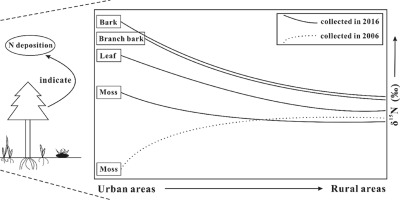Environmental Pollution ( IF 7.6 ) Pub Date : 2017-10-16 , DOI: 10.1016/j.envpol.2017.10.005 Yu Xu , Huayun Xiao , Hui Guan , Chaojun Long

|
Moss (as a reference material) and camphor (Cinnamomum Camphora) leaf, branch bark and bark samples were systematically collected across an urban-rural gradient in Guiyang (SW China) to determine the efficacy of using these bio-indicators to evaluate nitrogen (N) pollution. The tissue N concentrations (0.13%–2.70%) and δ15N values (−7.5‰ to +9.3‰) of all of these bio-indicators exhibited large spatial variations, as they recorded higher values in urban areas that quickly decreased with distance from the city center; moreover, both soil N concentrations and soil δ15N values were found no significant differences within each 6 km from the urban to the rural area. This not only suggests that the different N uptake strategies and variety of N responses of these bio-indicators can be reflected by their different susceptibilities to variations in N deposition but also reveals that they are able to indicate that urban N deposition is mostly from traffic and industry (NOx-N), whereas rural N deposition is mainly from agriculture (NHx-N). Compared to previously collected urban moss and camphor leaf samples, the significantly increased δ15N values in current urban moss and camphor leaf samples further indicate a greater contribution of NOx-N than NHx-N to urban N deposition. The feasibility of using the N concentrations and δ15N values of branch bark and bark as biomarkers of N deposition thus was further confirmed through the comparative use of these bio-indicators. It can be concluded that vascular plant leaves, branch bark and bark can be used as useful biomonitoring tools for evaluating atmospheric N pollution. For further study, quantitative criteria for the practical use of these bio-indicators in response to N deposition should be developed and the differences in the δ15N values of different plant parts should also be considered, particularly in urban environments that are severely disrupted by atmospheric pollution.











































 京公网安备 11010802027423号
京公网安备 11010802027423号